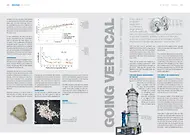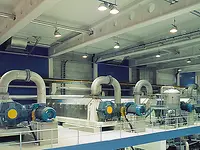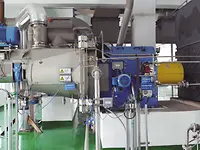Often, the simplest ideas are the best. After evaluating several different design concepts to address these two limitations of the SCP in low feed consistency applications, the solution turned out to be a quite simple one: turn a horizontal SCP on its end and feed it from the top. In a vertical configuration, gravity works in a positive way: evenly distributing the pulp suspension across the full circumference of the dewatering screen and ensuring 100% filling.
In a VST, the pulp suspension is fed into the top of the machine and gravity transports the pulp downwards. The risk of plugging the inlet screen at low feed consistency applications is almost eliminated. Similar to the SCP, the VST has a conical shaft and decreasing pitch so the pulp is compressed and dewatered as it moves downward. The pulp suspension is automatically and consistently refilled into the area between screw flights. The rotating shaft moves the pressed cake downwards to the outlet casing.
A pneumatically controlled counter-pressure ring builds up the pulp plug quickly after startup and releases the pulp when the proper consistency is achieved. The ring pressure can be adjusted to fine-tune discharge dryness or can be quickly unloaded to avoid plugging. The result is that higher throughput can be achieved with the VST.










